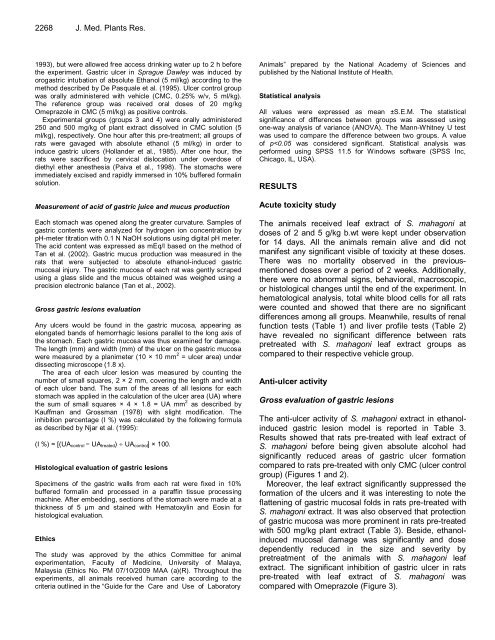Download Complete Issue - Academic Journals
Download Complete Issue - Academic Journals
Download Complete Issue - Academic Journals
Create successful ePaper yourself
Turn your PDF publications into a flip-book with our unique Google optimized e-Paper software.
2268 J. Med. Plants Res.<br />
1993), but were allowed free access drinking water up to 2 h before<br />
the experiment. Gastric ulcer in Sprague Dawley was induced by<br />
orogastric intubation of absolute Ethanol (5 ml/kg) according to the<br />
method described by De Pasquale et al. (1995). Ulcer control group<br />
was orally administered with vehicle (CMC, 0.25% w/v, 5 ml/kg).<br />
The reference group was received oral doses of 20 mg/kg<br />
Omeprazole in CMC (5 ml/kg) as positive controls.<br />
Experimental groups (groups 3 and 4) were orally administered<br />
250 and 500 mg/kg of plant extract dissolved in CMC solution (5<br />
ml/kg), respectively. One hour after this pre-treatment; all groups of<br />
rats were gavaged with absolute ethanol (5 ml/kg) in order to<br />
induce gastric ulcers (Hollander et al., 1985). After one hour, the<br />
rats were sacrificed by cervical dislocation under overdose of<br />
diethyl ether anesthesia (Paiva et al., 1998). The stomachs were<br />
immediately excised and rapidly immersed in 10% buffered formalin<br />
solution.<br />
Measurement of acid of gastric juice and mucus production<br />
Each stomach was opened along the greater curvature. Samples of<br />
gastric contents were analyzed for hydrogen ion concentration by<br />
pH-meter titration with 0.1 N NaOH solutions using digital pH meter.<br />
The acid content was expressed as mEq/l based on the method of<br />
Tan et al. (2002). Gastric mucus production was measured in the<br />
rats that were subjected to absolute ethanol-induced gastric<br />
mucosal injury. The gastric mucosa of each rat was gently scraped<br />
using a glass slide and the mucus obtained was weighed using a<br />
precision electronic balance (Tan et al., 2002).<br />
Gross gastric lesions evaluation<br />
Any ulcers would be found in the gastric mucosa, appearing as<br />
elongated bands of hemorrhagic lesions parallel to the long axis of<br />
the stomach. Each gastric mucosa was thus examined for damage.<br />
The length (mm) and width (mm) of the ulcer on the gastric mucosa<br />
were measured by a planimeter (10 × 10 mm 2 = ulcer area) under<br />
dissecting microscope (1.8 x).<br />
The area of each ulcer lesion was measured by counting the<br />
number of small squares, 2 × 2 mm, covering the length and width<br />
of each ulcer band. The sum of the areas of all lesions for each<br />
stomach was applied in the calculation of the ulcer area (UA) where<br />
the sum of small squares × 4 × 1.8 = UA mm 2 as described by<br />
Kauffman and Grossman (1978) with slight modification. The<br />
inhibition percentage (I %) was calculated by the following formula<br />
as described by Njar et al. (1995):<br />
(I %) = [(UAcontrol − UAtreated) UAcontrol] × 100.<br />
Histological evaluation of gastric lesions<br />
Specimens of the gastric walls from each rat were fixed in 10%<br />
buffered formalin and processed in a paraffin tissue processing<br />
machine. After embedding, sections of the stomach were made at a<br />
thickness of 5 µm and stained with Hematoxylin and Eosin for<br />
histological evaluation.<br />
Ethics<br />
The study was approved by the ethics Committee for animal<br />
experimentation, Faculty of Medicine, University of Malaya,<br />
Malaysia (Ethics No. PM 07/10/2009 MAA (a)(R). Throughout the<br />
experiments, all animals received human care according to the<br />
criteria outlined in the “Guide for the Care and Use of Laboratory<br />
Animals” prepared by the National Academy of Sciences and<br />
published by the National Institute of Health.<br />
Statistical analysis<br />
All values were expressed as mean ±S.E.M. The statistical<br />
significance of differences between groups was assessed using<br />
one-way analysis of variance (ANOVA). The Mann-Whitney U test<br />
was used to compare the difference between two groups. A value<br />
of p

















